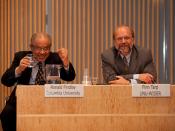Prejudice and discrimination are two values, which play a significant role in modern life. Between a psychological and sociological view there are 6 theories as to the cause of prejudice and discrimination. The purpose of this essay is to express my belief that all six of these theories best explain the origins of prejudice and discrimination because all six correlate with one another.
The psychological theories, which are authoritarian personality, group norms, and child development theory all have strengths and weaknesses. Authoritarian personality theory suggests that "parents who disciplined their children too harshly and who were cold, aloof, and bigoted created children with an authoritarian personality type" People with this personality type were found to be more prejudiced than others. Psychologists who have followed up on this theory found that people who are older, less educated, less intelligent, and from a lower social class are more likely to be authoritarian.
This theory's weakness was that this study never proved the existence of such a personality type; rather only showed that those with less education tend to be more prejudiced than those with higher levels of education are. An emphasized point in the theory of group norms is the in/out groups. Group norms theorists believe that within the in and out groups people readily adopt group norms: the attitudes, beliefs, and behaviors, as the price of belonging. Psychologists continue to build on Allport's work. One such study published in 2001 in the Canadian Journal of Behaviorism Science by G. Corenblum of Brandon University in Manitoba and Walter G. Stephan of New Mexico State University explored the attitudes and beliefs of aboriginal and European Canadians towards one another. They found for both the white and the aboriginal groups anxiety amongst group members was linked to negative contact with members of the opposite...


